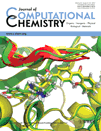Fast force field-based optimization of protein–ligand complexes with graphics processor
Lennart Heinzerling
Center for Bioinformatics, University of Hamburg, Bundesstr. 43, 20146 Hamburg, Germany
Search for more papers by this authorRobert Klein
Bayer CropScience AG, Industriepark Hoechst, G836, 65926 Frankfurt am Main, Germany
Search for more papers by this authorCorresponding Author
Matthias Rarey
Center for Bioinformatics, University of Hamburg, Bundesstr. 43, 20146 Hamburg, Germany
Center for Bioinformatics, University of Hamburg, GermanySearch for more papers by this authorLennart Heinzerling
Center for Bioinformatics, University of Hamburg, Bundesstr. 43, 20146 Hamburg, Germany
Search for more papers by this authorRobert Klein
Bayer CropScience AG, Industriepark Hoechst, G836, 65926 Frankfurt am Main, Germany
Search for more papers by this authorCorresponding Author
Matthias Rarey
Center for Bioinformatics, University of Hamburg, Bundesstr. 43, 20146 Hamburg, Germany
Center for Bioinformatics, University of Hamburg, GermanySearch for more papers by this authorAbstract
Usually based on molecular mechanics force fields, the post-optimization of ligand poses is typically the most time-consuming step in protein–ligand docking procedures. In return, it bears the potential to overcome the limitations of discretized conformation models. Because of the parallel nature of the problem, recent graphics processing units (GPUs) can be applied to address this dilemma. We present a novel algorithmic approach for parallelizing and thus massively speeding up protein–ligand complex optimizations with GPUs. The method, customized to pose-optimization, performs at least 100 times faster than widely used CPU-based optimization tools. An improvement in Root-Mean-Square Distance (RMSD) compared to the original docking pose of up to 42% can be achieved. © 2012 Wiley Periodicals, Inc.
Supporting Information
Additional Supporting Information may be found in the online version of this article.
| Filename | Description |
|---|---|
| JCC_23094_sm_SuppInfo.pdf25.4 KB | Supporting Information |
Please note: The publisher is not responsible for the content or functionality of any supporting information supplied by the authors. Any queries (other than missing content) should be directed to the corresponding author for the article.
References
- 1 H. Perez-Sánchez, W. Wenzel, Curr. Comput. Aided Drug Des. 2011, 7, 44.
- 2 NVIDIA Corporation, GPU Supercomputing Solutions, Available at: http://www.nvidia.com/object/personal-supercomputing.html, [Online, accessed 27-March-2012].
- 3 J. Stone, J. Phillips, P. Freddolino, D. Hardy, L. Trabuco, K. Schulten, J. Comput. Chem. 2007, 28, 2618.
- 4 M. J. Harvey, G. De Fabritiis, J. Chem. Theory Comput. 2009, 5, 2371.
- 5 J. van Meel, A. Arnold, D. Frenkel, S. Zwart, R. Belleman, Mol. Simul. 2008, 34, 259.
- 6 N. Schmid, M. Botschi, W. Van Gunsteren, J. Comput. Chem. 2010, 31, 1636.
- 7 M. Christen, P. H. Hünenberger, D. Bakowies, R. Baron, R. Bürgi, D. P. Geerke, T. N. Heinz, M. A. Kastenholz, V. Kraeutler, C. Oostenbrink, C. Peter, D. Trzesniak, W. F. van Gunsteren, J. Comput. Chem. 2005, 26, 1719.
- 8 J. A. Anderson, C. D. Lorenz, A. Travesset, J. Comput. Phys. 2008, 227, 5342.
- 9 M. Friedrichs, P. Eastman, V. Vaidyanathan, M. Houston, S. Legrand, A. Beberg, D. Ensign, C. Bruns, V. Pande, J. Comput. Chem. 2009, 30, 864.
- 10 P. Eastman, V. Pande, J. Comput. Chem. 2010, 31, 1268.
- 11 P. Eastman, V. Pande, Comput. Sci. Eng. 2010, 12, 34.
- 12 A. Spitzmueller, H. Velec, G. Klebe, J. Chem. Inf. Model. 2011, 51, 1423.
- 13 M. Mizutani, Y. Takamatsu, T. Ichinose, K. Nakamura, A. Itai, Proteins 2006, 63, 878.
- 14 J. Schlosser, M. Rarey, J. Chem. Inf. Model. 2009, 49, 800.
- 15 C. Bissantz, B. Kuhn, M. Stahl, J. Med. Chem. 2010, 53, 5061.
- 16 Yet Another Scientific Artificial Reality Application (YASARA), Version 11.9.18. 2011. Available at: http://www.yasara.org.
- 17 Chemical Computing Group (CCG), Molecular Operating Environment (MOE), Version 2010.10.
- 18 M. Hartshorn, M. Verdonk, G. Chessari, S. Brewerton, W. Mooij, P. Mortenson, C. Murray, J. Med. Chem. 2007, 50, 726.
- 19 S. Weiner, P. Kollman, D. Case, U. Singh, C. Ghio, G. Alagona, S. Profeta, P. Weiner, J. Am. Chem. Soc. 1984, 106, 765.
- 20 M. Clark, R. Cramer, N. Van Opdenbosch, J. Comput. Chem. 1989, 10, 982.
- 21PDB format, http://www.wwpdb.org/documentation/format32/v3.2.html, Accessed on March 27, 2012.
- 22 TRIPOS International, MOL2 format, http://tripos.com/index.php, Accessed on March 27, 2012.
- 23 M. Beachy, D. Chasman, R. Murphy, T. Halgren, R. Friesner, J. Am. Chem. Soc. 1997, 119, 5908.
- 24 G. M. Keseru, I. Kolossvary, Molecular Mechanics and Conformational Analysis in Drug Design; Blackwell: London, UK, 1999; 176 pp.
- 25 B. R. Brooks, R. E. Bruccoleri, B. D. Olafson, D. J. States, S. Swaminathan, M. Karplus, J. Comput. Chem. 1983, 4, 187.
- 26 W. L. Jorgensen, J. Tirado-Rives, J. Am. Chem. Soc. 1988, 110, 1657.
- 27 T. Halgren, J. Comput. Chem. 1996, 17, 490.
- 28 J. Gasteiger, M. Marsili, Tetrahedron 1980, 36, 3219.
- 29 J. Hoberock, N. Bell, Thrust: A Parallel Template Library, 2010. Available at: http://www.meganewtons.com/, Version 1.3.0.
- 30 S. Kirkpatrick, C. Gelatt, M. Vecchi, Science 1983, 220, 671.
- 31 Y. Duan, C. Wu, S. Chowdhury, M. Lee, G. Xiong, W. Zhang, R. Yang, P. Cieplak, R. Luo, T. Lee, J. Caldwell, J. Wang, P. Kollman, J. Comput. Chem. 2003, 24, 1999.
- 32 T. Pencheva, D. Lagorce, I. Pajeva, B. Villoutreix, M. Miteva, BMC Bioinf. 2008, 9, 438.
- 33 A. Klenner, M. Weisel, F. Reisen, E. Proschak, G. Schneider, Mol. Inform 2010, 29, 189.
- 34 S. Nabuurs, M. Wagener, J. De Vlieg, J. Med. Chem. 2007, 50, 6507.
- 35 S. Leis, M. Zacharias, J. Comput. Chem. 2011, 32, 3433.
- 36 S. Kazemi, D. Kruger, F. Sirockin, H. Gohlke, ChemMedChem 2009, 4, 1264.




